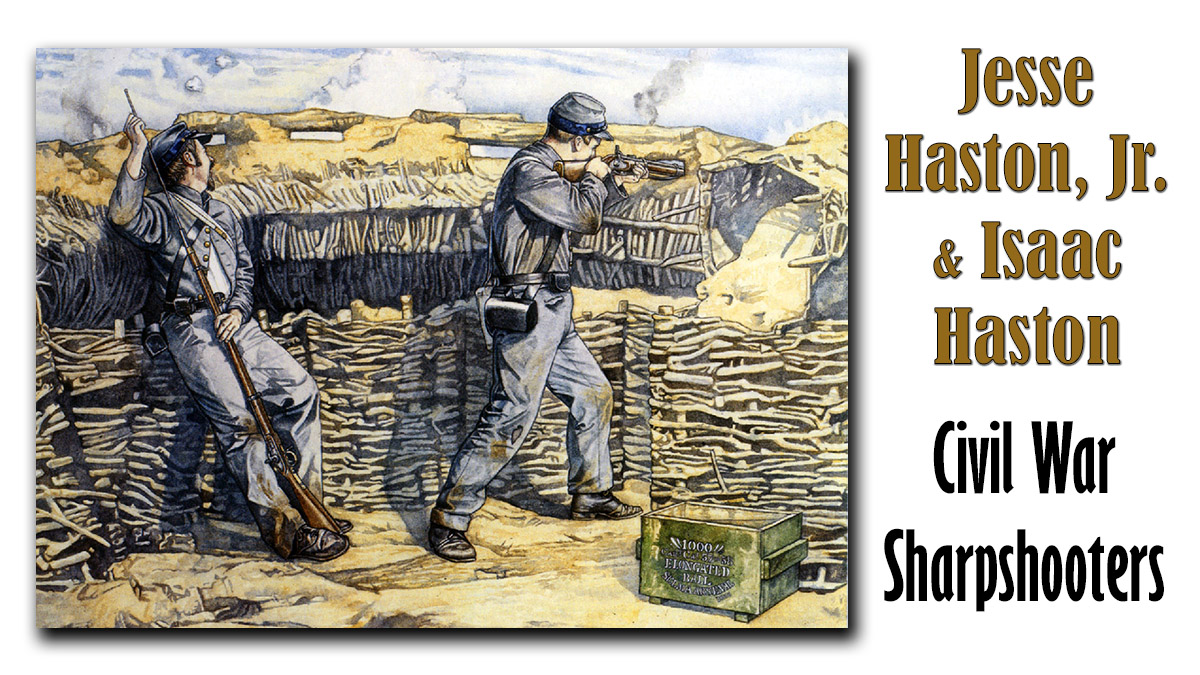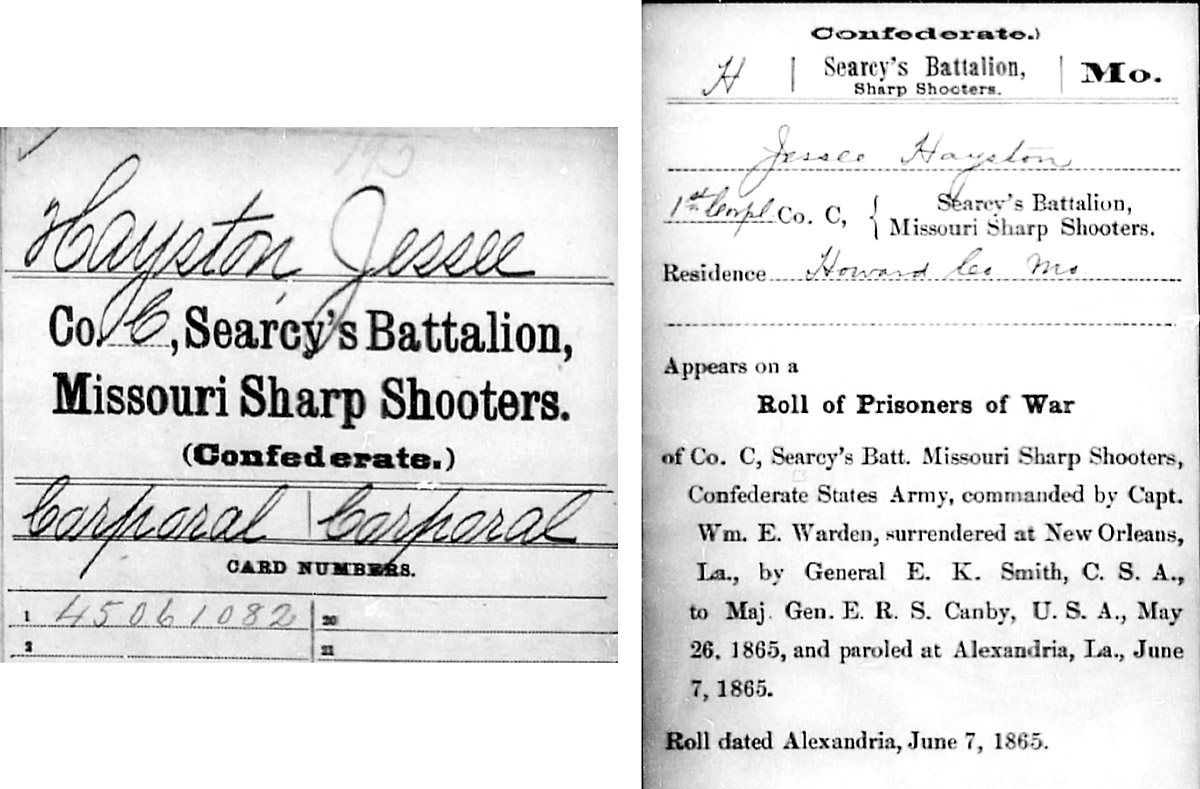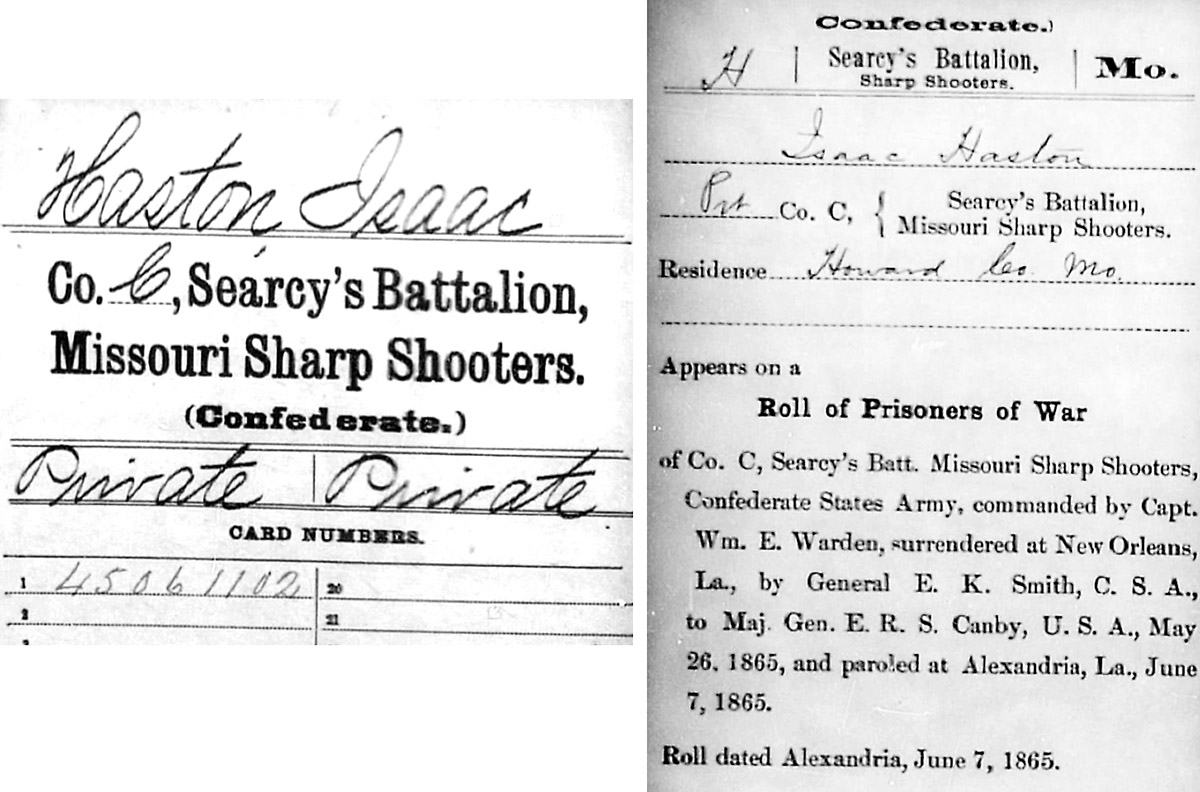Civil War Sharpshooters - Jesse, Jr. and Isaac Haston
Sons of Jesse Haston, Sr. & Grandsons of Daniel Haston

You may have read the story of William A. Haston, who served in the Mexican War. If so, you will recall that he was a son of Jesse Haston, Daniel’s son. Well, two of his brothers (Jesse, Jr. and Isaac) had their own war experiences–as “sharpshooters” in the Civil War.
What or who was a sharpshooter?
During the Revolutionary War, George Washington used men with extraordinarily long-distance shooting skills to pick off British cannoneers in their fortifications at Yorktown. But it wasn’t until the American Civil War that sharpshooters began to play a prominent role in warfare. By 1855, log-barreled rifled muskets were available that were accurate to at least 500 yards, but capable of killing beyond that.
Both sides of the Civil War recruited special sharpshooter units, but the Union Army was first to create these units. Hiram Berdan was known as the top amateur rifle shot in the United States. Early in the war, he proposed the idea of raising a unit for the Union Army in which each potential recruit would have to pass a shooting test to become a member. The basic requirement: Shoot ten consecutive shots at a target 600 feet away, putting the bullets on an average of five inches from the bulls eye.

These Sharpshooter units prided themselves in being elite troops. They received special training and were often exempt from some of the more rigorous types of training and disliked activities such as sentry duty. They sometimes wore special uniforms or emblems to distinguish them from other soldiers. And, in theory at least, they received higher pay.
Although they were promised these and other special benefits in the recruiting process, often they ended up being regular infantry men and called on for sharp shooting duties only on special occasions.
There were several ways in which sharpshooters were commonly used, if and when their commanding officers realized their unique value.
Skirmishers. Sharpshooters were often placed in the forefront of the battle, probing the enemy and screening the main body of the arm from attack or surprise. But doing so they impeded the advance of the enemy. They used the terrain to their advantage. Confederate sharpshooters also became experts in raiding.
Scouts. When they were not fighting, sharpshooters often were scouting. Their training in measurability fitted them for the task of scouting.
Snipers. When equipped with long-range target or scoped rifles, sharpshooters were sometimes used to “take out” the enemy’s signal men, officers, gunboats, and artillery personnel.
Stalkers. Sometimes sharpshooters even stalked their prey, especially some of the more important targets, such as enemy officers. They would maneuver into position to await clear-shot appearances of their targets. Sometimes they would remain in a position for hours without food or water, waiting for the right moment to get their shots.
Not every officer deployed sharpshooters as snipers and stalkers. Many of the officers on both sides considered sniping and stalking to be murder, not war.
Sharpshooting in the Confederacy
The Haston Boys as Confederate Sharpshooters
Daniel’s son, Jesse, was the only son in the Daniel Haston family who owned slaves. David didn’t. Joseph didn’t. Daniel, Jr. didn’t. Isaac didn’t. Jeremiah didn’t. I suspect that their Mennonite background conditioned them to oppose slavery. But when son Jesse moved to Missouri and acquired a lot of land, he became a slave owner. If his father, Daniel, had lived long enough to have known it, I think he would have been disappointed with Jesse.
However, it appears that Jesse and his family for the most part tried to maintain a neutral stance during the Civil War. Yes, Abi Albert Haston, son of Jesse, migrated to Kansas where he purchased mules, cattle, etc., for the United States government and moved in wagon trains between Ft. Leavenworth, Ft. Dodge and Santa Fe, being accompanied by soldiers, and following the Santa Fe trail. Another son, Thomas J. Haston, signed the oath of allegiance to the United States on January 26, 1862. Thomas may have been under pressure to do so because of some kind of previous rebel guerrilla activity–just a guess. But otherwise the Haston boys seem to have avoided taking sides.
Jesse Haston Ambushed and Killed
In the aftermath of the October 15, 1864, Battle of Glasgow (Missouri), Jesse Haston (Daniel’s son) was shot and killed by a Yankee militia soldier (or soldiers). Unfortunately, due to the civil disruptions of wartime, the details of Jesse’s death were not recorded in newspaper article nor was his obituary published. But the Haston family account of his death has been passed down from generation to generation.
Jesse was considered a Southerner during the Civil War and the Northern troops raided his home during the war, taking everything of value, including a number of horses. He went and talked to them at Glasgow, and they let him have one horse, then followed him out of town, shot him and took the horse. He died a few days later and is buried in the cemetery just east of his house.[i]
[i] Louise Haston Rice, (unpublished manuscript, n.d).
Jesse, Jr. and Isaac Haston - Sons of Jesse, Sr. - Enroll as Confederate Sharpshooters
It appears to me that these two sons of Jesse Haston had attempted to remain neutral during the war. They were of prime ages to be fighting in the war, for one side or the other. Even as late as February 28, 1865, Isaac Hasting (Haston) of Chariton County, Missouri was “drafted [by the Union Provost Marshal] & failed to report.” A line was marked through his name and other information. However, his record does not say that he was “in rebel army” as was true of several other records on the same page. Jesse Hasting’s (Haston’s) name appears just below Isaac’s (also in Chariton County) with no line marked through his personal information and no note regarding having been drafted, etc.[i]
[i] Consolidated Enrollment Lists, 1863-1865 (Civil War Union Draft Records); NAI: 4213514; Archive Volume Number: 1 of 1. (National Archives and Records, Washington, D.C.)
Jesse’s sons Jesse, [sic, Hayston] Jr.[i] and Isaac[ii] at some point in time enrolled in Company C of Searcy’s Battalion of Missouri Confederate Sharp Shooters. Since we don’t know when they enrolled, it may be that their father’s death by a Yankee ambusher prompted them to become sharpshooters in the Confederate army.
They appeared on a roll of prisoners of war, paroled at Alexandria, Louisiana on June 7, 1865. They had surrendered in New Orleans, 13 days earlier. Isaac was a private and his slightly older brother, Jesse, was a corporal. It appears, by the card numbers, that Jesse was 20 men ahead of Isaac in the line of enlistees. There were six Venables in the company, probably related to Jesse and Isaac by marriage.[iii]
[i] “Jessee Hayston,” Fold3.com, accessed February 12, 2021, https://www.fold3.com/image/185506005 and /image/185506006.
[ii] “Isaac Haston,” Fold3.com, accessed February 12, 2021, https://www.fold3.com/image/ 185506002 and /image/ 185506003.
[iii] Kenneth E. Weant, Civil War Records Missouri Confederate Infantry, 12th & 16th Regiments, Volume 3. (Arlington, TX: published by author, 2009), 73.
We have no records to tell us when Jesse, Jr. and Isaac enlisted or mustered. The only known document of their service is the parole document, dated June 7, 1865.


Jesse’s sons Jesse, [sic, Hayston] Jr.[i] and Isaac Hastib[ii] were enrolled in Company C of Searcy’s Battalion of Missouri Confederate Sharp Shooters. They appeared on a roll of prisoners of war, paroled at Alexandria, Louisiana on June 7, 1865. Isaac was a private and his slightly older brother, Jesse, was a corporal. It appears, by the card numbers, that Jesse was 20 men ahead of Isaac in the line of enlistees. There were six Venables in the company, probably related to Jesse and Isaac by marriage.[iii]
[i] “Jessee Hayston,” Fold3.com, accessed February 12, 2021, https://www.fold3.com/image/185506005 and /image/185506006.
[ii] “Isaac Haston,” Fold3.com, accessed February 12, 2021, https://www.fold3.com/image/ 185506002 and /image/ 185506003.
[iii] Kenneth E. Weant, Civil War Records Missouri Confederate Infantry, 12th & 16th Regiments, Volume 3. (Arlington, TX: published by author, 2009), 73.
If you appreciated this article, please share it with others who might also enjoy it.

